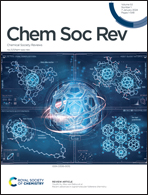Boryl-substituted low-valent heavy group 14 compounds
Abstract
Low valent group 14 compounds exhibit diverse structures and reactivities. The employment of diazaborolyl anions (NHB anions), isoelectronic analogues to N-heterocyclic carbenes (NHCs), in group 14 chemistry leads to the exceptional structures and reactivity. The unique combination of σ-electron donation and pronounced steric hindrance impart distinct structural characteristics to the NHB-substituted low valent group 14 compounds. Notably, the modulation of the HOMO–LUMO gap in these compounds with the diazaborolyl substituents results in novel reaction patterns in the activation of small molecules and inert chemical bonds. This review mainly summarizes the recent advances in NHB-substituted low-valent heavy Group 14 compounds, emphasizing their synthesis, structural characteristics and application to small molecule activation.

- This article is part of the themed collection: Applications of Main Group Chemistry in Synthesis, Catalysis, and Biomedical and Materials Research


 Please wait while we load your content...
Please wait while we load your content...